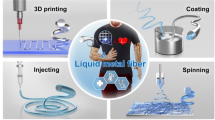Abstract
Positive chemically amplified molecular glass with pendant t-butyloxy carbonyl (t-BOC) groups based on β-cyclodextrin (β-CD) was prepared. The β-CD derivatives were obtained from the reaction of β-CD and di-tert-butyl dicarbonate (DBDC) in the presence of 4-dimethylaminopyridine, and the protecting ratio was controlled using various feed amounts of DBDC. Fourier-transform infrared spectroscopy and proton nuclear magnetic resonance were employed to characterize the chemical structure, indicating that the synthesis was successful. Thermal behavior was characterized by thermogravimetric analysis; the results showed that the initial thermal decomposition temperature occurred at approximately 160 °C, which could satisfy the lithography process. Ultraviolet–visible spectrophotometer indicated that the t-BOC-protected β-CD derivatives had low absorbance at 365 nm wavelength. Additionally, X-ray diffraction analysis results showed that the β-CD derivatives had amorphous form, and exhibited excellent film-forming property. The photoresists consisting of different t-BOC protecting groups showed high sensitivity when exposed to 365 nm light and post-baked at 105 °C for 90 s, followed by developing in 2.38 wt% aqueous tetramethylammonium hydroxide solution at room temperature. An enhanced line and space positive patterns with 1 μm resolution were delineated according to digital microscope.








Similar content being viewed by others
References
Reichmanis E, Houlihan FM, Nalamasu O, Neenan TX (1991) Chemical amplification mechanisms for microlithography. Chem Mater 3:394–407
Henderson CL (2012) Photoresists and advanced patterning. Polym Sci A Compr Ref 8:37–76
Lin QH (2007) Properties of photoresist polymers. Phys Prop Polym Handb. doi:10.1007/978-0-387-69002-5_57
Ito H (2005) Chemical amplification resists for microlithography. Adv Polym Sci 172:37–245
Xuefeng H, Engelmann S, Oehrlein GS (2006) Studies of plasma surface interactions during short time plasma etching of 193 and 248 nm photoresist materials. J Vac Sci Technol B 24:1850–1858
Silva AD, Felix NM, Ober CK (2008) Molecular glass resists as high-resolution patterning materials. Adv Mater 20:3355–3361
Gogolides E, Constantoudis V, Patsis GP, Tserepi A (2006) A review of line edge roughness and surface nanotexture resulting from patterning processes. Microelectron Eng 83:1067–1072
Patsis GP, Gogolides E (2007) Effects of model polymer chain architectures and molecular weight of conventional and chemically amplified photoresists on line-edge roughness. Stochastic simulations. Microelectron Eng 83:1078–1081
Drygiannakis D, Patsis GP, Raptis I, Niakoula D, Vidali V et al (2007) Stochastic simulation studies of molecular resists. Microelectron Eng 84:1062–1065
Gil KY, Kim JB, Fujigaya T, Shibasaki Y, Ueda M (2002) A positive-working alkaline developable photoresist based on partially tert-Boc-protected calix[4]resorcinarene and a photoacid generator. J Mater Chem 12:53–57
Liu J, Liu ZP, Wang LY, Sun HY (2014) Single-component chemically amplified i-line molecular glass photoresist based on calix[4]resorcinarenes. Chin Sci Bull 59:1097–1103
Yang D, Chang SW, Ober CK (2006) Molecular glass photoresists for advanced lithography. J Mater Chem 16:1693–1696
Kudo H, Suyama Y, Oizumi H et al (2010) Novel extreme ultraviolet (EUV)-resist material based on noria (water wheel-like cyclic oligomer). J Mater Chem 20:4445–4450
Lawson RA, Lee CT, Tolbert LM, Younkin TR, Henderson CL (2009) High resolution negative tone molecular resist based on di-functional epoxide polymerization. Microelectron Eng 86:734–737
Kadota T, Kageyama H, Wakaya F, Gamo K, Shirota Y (1999) Amorphous molecular materials: development of a novel positive electron molecular resist. J Photopolym Sci Tec 12:375–376
Liao YY, Liu JH (2008) Preparation and characterization of molecular photoresists: crosslinkable positive and water developable negative tones. J Appl Polym Sci 109:3849–3858
Kwon Y, Yun H, Ganesan R (2006) High performance molecular resists based on β-cyclodextrin. Polym J 38:996–998
Yu JX, Xu N, Liu ZP, Wang LY (2012) Novel one-component positive-tone chemically amplified i-line molecular glass photoresists. ACS Appl Mater Inter 4:2591–2596
Takeshi K, Nakayama R, Ueda M (1998) A positive-working alkaline developable photoresist based on t-boc-calix(4)resorcinarene and a photoacid generator. Chem Lett 1998:865–866
Valle EMMD (2004) Cyclodextrins and their uses: a review. Process Biochem 39:1033–1046
Qi W, Wang LY (2015) Novel one-component positive-tone chemically amplified I-line molecular glass photoresist based on tannic acid. Chem Res Chin Univ 31:585–589
Shirota Y (2000) Organic materials for electronic and optoelectronic devices. J Mater Chem 10:1–25
Acknowledgments
This work was supported by Innovation Foundation of Jiangsu (No. BY2015019-14), the National Science and Technology Major Project of China (No. 2010ZX02304), and the Jiangsu Postgraduate Scientific Research and Innovation Plan Project (No. KYLX_1127).
Author information
Authors and Affiliations
Corresponding authors
Rights and permissions
About this article
Cite this article
Li, H., Zhou, Z., Liu, J. et al. One-pot synthesis of molecular glass photoresists based on β-cyclodextrin containing a t-butyloxy carbonyl group for i-line lithography. Polym. Bull. 74, 1091–1101 (2017). https://doi.org/10.1007/s00289-016-1765-5
Received:
Revised:
Accepted:
Published:
Issue Date:
DOI: https://doi.org/10.1007/s00289-016-1765-5




